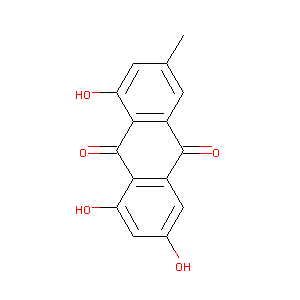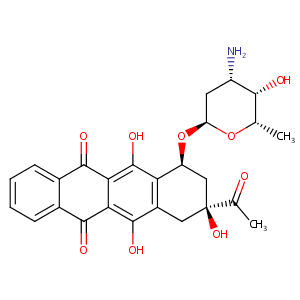| DOT Name |
DOT ID |
UniProt ID |
Mode of Action |
REF |
|
Cytochrome P450 1A1 (CYP1A1)
|
OTE4EFH8
|
CP1A1_HUMAN
|
Increases Expression
|
[12] |
|
Cytochrome P450 1B1 (CYP1B1)
|
OTYXFLSD
|
CP1B1_HUMAN
|
Increases Expression
|
[12] |
|
Etoposide-induced protein 2.4 homolog (EI24)
|
OTD4NOYS
|
EI24_HUMAN
|
Increases Expression
|
[5] |
|
Protein phosphatase 1D (PPM1D)
|
OT8NLZ9D
|
PPM1D_HUMAN
|
Increases Expression
|
[5] |
|
Growth arrest-specific protein 2 (GAS2)
|
OT50JKXQ
|
GAS2_HUMAN
|
Increases Expression
|
[5] |
|
Rho-associated protein kinase 2 (ROCK2)
|
OTVYN14T
|
ROCK2_HUMAN
|
Decreases Expression
|
[5] |
|
G2/mitotic-specific cyclin-B2 (CCNB2)
|
OTIEXTDK
|
CCNB2_HUMAN
|
Decreases Expression
|
[5] |
|
Dihydrofolate reductase (DHFR)
|
OT3DVIGM
|
DYR_HUMAN
|
Decreases Expression
|
[5] |
|
RAF proto-oncogene serine/threonine-protein kinase (RAF1)
|
OT51LSFO
|
RAF1_HUMAN
|
Decreases Expression
|
[5] |
|
Retinoblastoma-associated protein (RB1)
|
OTQJUJMZ
|
RB_HUMAN
|
Decreases Expression
|
[5] |
|
Glutathione peroxidase 1 (GPX1)
|
OTE2O72Q
|
GPX1_HUMAN
|
Increases Expression
|
[5] |
|
Cathepsin D (CTSD)
|
OTQZ36F3
|
CATD_HUMAN
|
Decreases Expression
|
[5] |
|
Keratin, type I cytoskeletal 19 (KRT19)
|
OTDGDQ75
|
K1C19_HUMAN
|
Decreases Expression
|
[5] |
|
Microtubule-associated protein tau (MAPT)
|
OTMTP2Z7
|
TAU_HUMAN
|
Decreases Expression
|
[5] |
|
Cyclin-dependent kinase 4 (CDK4)
|
OT7EP05T
|
CDK4_HUMAN
|
Decreases Expression
|
[5] |
|
Glutathione S-transferase Mu 3 (GSTM3)
|
OTLA2WJT
|
GSTM3_HUMAN
|
Decreases Expression
|
[5] |
|
DnaJ homolog subfamily B member 1 (DNAJB1)
|
OTCOSEVH
|
DNJB1_HUMAN
|
Increases Expression
|
[5] |
|
NF-kappa-B inhibitor alpha (NFKBIA)
|
OTFT924M
|
IKBA_HUMAN
|
Increases Expression
|
[5] |
|
Calnexin (CANX)
|
OTYP1F6J
|
CALX_HUMAN
|
Decreases Expression
|
[5] |
|
Peroxiredoxin-6 (PRDX6)
|
OTS8KC8A
|
PRDX6_HUMAN
|
Increases Expression
|
[5] |
|
RAC-alpha serine/threonine-protein kinase (AKT1)
|
OT8H2YY7
|
AKT1_HUMAN
|
Decreases Expression
|
[5] |
|
Stress-induced-phosphoprotein 1 (STIP1)
|
OT7TXLOX
|
STIP1_HUMAN
|
Decreases Expression
|
[5] |
|
Transforming protein RhoA (RHOA)
|
OT6YOJ9N
|
RHOA_HUMAN
|
Decreases Expression
|
[5] |
|
Actin, alpha skeletal muscle (ACTA1)
|
OTOVGLPG
|
ACTS_HUMAN
|
Decreases Expression
|
[5] |
|
Protein kinase C delta type (PRKCD)
|
OTSEH90E
|
KPCD_HUMAN
|
Decreases Expression
|
[5] |
|
Forkhead box protein O1 (FOXO1)
|
OTPJRB6D
|
FOXO1_HUMAN
|
Increases Expression
|
[5] |
|
TNF receptor-associated factor 2 (TRAF2)
|
OT1MEZZN
|
TRAF2_HUMAN
|
Increases Expression
|
[5] |
|
Serine-protein kinase ATM (ATM)
|
OTQVOHLT
|
ATM_HUMAN
|
Increases Expression
|
[5] |
|
Phosducin-like protein (PDCL)
|
OTDNHIXG
|
PHLP_HUMAN
|
Decreases Expression
|
[5] |
|
Rho-associated protein kinase 1 (ROCK1)
|
OTSXYVW1
|
ROCK1_HUMAN
|
Decreases Expression
|
[5] |
|
Cyclin-dependent kinase 13 (CDK13)
|
OT3P7JF1
|
CDK13_HUMAN
|
Decreases Expression
|
[5] |
|
Translation initiation factor eIF2B subunit alpha (EIF2B1)
|
OT4NCVY1
|
EI2BA_HUMAN
|
Decreases Expression
|
[5] |
|
Reticulocalbin-2 (RCN2)
|
OTIU8JWD
|
RCN2_HUMAN
|
Increases Expression
|
[5] |
|
Inositol 1,4,5-trisphosphate receptor type 1 (ITPR1)
|
OTX7MWW1
|
ITPR1_HUMAN
|
Decreases Expression
|
[5] |
|
Transcription factor E2F5 (E2F5)
|
OT1XWING
|
E2F5_HUMAN
|
Increases Expression
|
[5] |
|
Tubulin-specific chaperone C (TBCC)
|
OTBF0X8R
|
TBCC_HUMAN
|
Decreases Expression
|
[5] |
|
Phosphatidylinositol 3-kinase catalytic subunit type 3 (PIK3C3)
|
OTLUM9L7
|
PK3C3_HUMAN
|
Increases Expression
|
[5] |
|
Transcription factor SPT20 homolog (SUPT20H)
|
OTTMC0LH
|
SP20H_HUMAN
|
Increases Expression
|
[5] |
|
Alpha-N-acetylneuraminide alpha-2,8-sialyltransferase (ST8SIA1)
|
OTGND2YZ
|
SIA8A_HUMAN
|
Increases Expression
|
[5] |
|
Serine/threonine-protein kinase TAO3 (TAOK3)
|
OTYBATSH
|
TAOK3_HUMAN
|
Decreases Expression
|
[5] |
|
Cadherin EGF LAG seven-pass G-type receptor 3 (CELSR3)
|
OT8P6QNJ
|
CELR3_HUMAN
|
Decreases Expression
|
[5] |
|
Bifunctional apoptosis regulator (BFAR)
|
OTTBG0V7
|
BFAR_HUMAN
|
Decreases Expression
|
[5] |
|
Very-long-chain (HACD3)
|
OTISMCAF
|
HACD3_HUMAN
|
Decreases Expression
|
[5] |
|
SUMO-activating enzyme subunit 1 (SAE1)
|
OT18HFX5
|
SAE1_HUMAN
|
Decreases Expression
|
[5] |
|
BAG family molecular chaperone regulator 5 (BAG5)
|
OT0J97C6
|
BAG5_HUMAN
|
Decreases Expression
|
[5] |
|
Microtubule-actin cross-linking factor 1, isoforms 1/2/3/4/5 (MACF1)
|
OTVIHD77
|
MACF1_HUMAN
|
Decreases Expression
|
[5] |
|
Cytochrome P450 2C9 (CYP2C9)
|
OTGLBN29
|
CP2C9_HUMAN
|
Decreases Activity
|
[13] |
|
Sulfotransferase 1A1 (SULT1A1)
|
OT0K7JIE
|
ST1A1_HUMAN
|
Decreases Activity
|
[13] |
|
Baculoviral IAP repeat-containing protein 5 (BIRC5)
|
OTILXZYL
|
BIRC5_HUMAN
|
Decreases Expression
|
[7] |
|
Aldo-keto reductase family 1 member B10 (AKR1B10)
|
OTOA4HTH
|
AK1BA_HUMAN
|
Decreases Activity
|
[14] |
|
Tyrosine-protein kinase JAK2 (JAK2)
|
OTBIDOOR
|
JAK2_HUMAN
|
Decreases Phosphorylation
|
[7] |
|
Microphthalmia-associated transcription factor (MITF)
|
OT6XJCZH
|
MITF_HUMAN
|
Decreases Expression
|
[6] |
|
Aflatoxin B1 aldehyde reductase member 3 (AKR7A3)
|
OTW3GO4Y
|
ARK73_HUMAN
|
Decreases Activity
|
[14] |
|
Estrogen receptor (ESR1)
|
OTKLU61J
|
ESR1_HUMAN
|
Increases Activity
|
[15] |
|
Heme oxygenase 1 (HMOX1)
|
OTC1W6UX
|
HMOX1_HUMAN
|
Increases Expression
|
[16] |
|
Poly polymerase 1 (PARP1)
|
OT310QSG
|
PARP1_HUMAN
|
Increases Activity
|
[7] |
|
Apoptosis regulator Bcl-2 (BCL2)
|
OT9DVHC0
|
BCL2_HUMAN
|
Decreases Expression
|
[7] |
|
Cytochrome P450 2D6 (CYP2D6)
|
OTZJC802
|
CP2D6_HUMAN
|
Decreases Activity
|
[17] |
|
DNA topoisomerase 2-alpha (TOP2A)
|
OT6LPS08
|
TOP2A_HUMAN
|
Increases Activity
|
[18] |
|
Proto-oncogene tyrosine-protein kinase Src (SRC)
|
OTETYX40
|
SRC_HUMAN
|
Decreases Phosphorylation
|
[7] |
|
NAD(P)H dehydrogenase 1 (NQO1)
|
OTZGGIVK
|
NQO1_HUMAN
|
Increases Expression
|
[16] |
|
Histone H2AX (H2AX)
|
OT18UX57
|
H2AX_HUMAN
|
Increases Expression
|
[19] |
|
Carbonyl reductase 1 (CBR1)
|
OTQ3A541
|
CBR1_HUMAN
|
Decreases Activity
|
[14] |
|
Platelet endothelial cell adhesion molecule (PECAM1)
|
OTXOM4D9
|
PECA1_HUMAN
|
Decreases Expression
|
[7] |
|
Tyrosine-protein kinase JAK1 (JAK1)
|
OT0X3D17
|
JAK1_HUMAN
|
Decreases Phosphorylation
|
[7] |
|
Tumor necrosis factor receptor superfamily member 6 (FAS)
|
OTP9XG86
|
TNR6_HUMAN
|
Increases Expression
|
[20] |
|
Mitogen-activated protein kinase 3 (MAPK3)
|
OTCYKGKO
|
MK03_HUMAN
|
Decreases Phosphorylation
|
[20] |
|
Mitogen-activated protein kinase 1 (MAPK1)
|
OTH85PI5
|
MK01_HUMAN
|
Decreases Phosphorylation
|
[20] |
|
Tyrosine-protein phosphatase non-receptor type 6 (PTPN6)
|
OT33XNZM
|
PTN6_HUMAN
|
Increases Expression
|
[7] |
|
Peroxisome proliferator-activated receptor gamma (PPARG)
|
OTHMARHO
|
PPARG_HUMAN
|
Increases Expression
|
[21] |
|
L-dopachrome tautomerase (DCT)
|
OTYVNTBG
|
TYRP2_HUMAN
|
Decreases Expression
|
[6] |
|
Signal transducer and activator of transcription 3 (STAT3)
|
OTAAGKYZ
|
STAT3_HUMAN
|
Affects Localization
|
[7] |
|
Hepatocyte nuclear factor 4-alpha (HNF4A)
|
OTY1TOAB
|
HNF4A_HUMAN
|
Decreases Expression
|
[8] |
|
Aldo-keto reductase family 1 member C3 (AKR1C3)
|
OTU2SXBA
|
AK1C3_HUMAN
|
Decreases Activity
|
[14] |
|
Caspase-3 (CASP3)
|
OTIJRBE7
|
CASP3_HUMAN
|
Increases Activity
|
[7] |
|
Tumor necrosis factor ligand superfamily member 6 (FASLG)
|
OTZARCHH
|
TNFL6_HUMAN
|
Increases Expression
|
[20] |
|
BH3-interacting domain death agonist (BID)
|
OTOSHSHU
|
BID_HUMAN
|
Increases Degradation
|
[20] |
|
Apoptosis regulator BAX (BAX)
|
OTAW0V4V
|
BAX_HUMAN
|
Affects Expression
|
[20] |
|
Induced myeloid leukemia cell differentiation protein Mcl-1 (MCL1)
|
OT2YYI1A
|
MCL1_HUMAN
|
Decreases Expression
|
[7] |
|
Oxysterols receptor LXR-alpha (NR1H3)
|
OT54YZ9I
|
NR1H3_HUMAN
|
Increases Expression
|
[6] |
|
Maternal embryonic leucine zipper kinase (MELK)
|
OTEY2UQA
|
MELK_HUMAN
|
Decreases Expression
|
[22] |
|
Caspase-8 (CASP8)
|
OTA8TVI8
|
CASP8_HUMAN
|
Increases Activity
|
[20] |
|
Solute carrier family 22 member 6 (SLC22A6)
|
OTKRCBVM
|
S22A6_HUMAN
|
Decreases Activity
|
[23] |
|
Organic anion transporter 3 (SLC22A8)
|
OT8BY933
|
S22A8_HUMAN
|
Decreases Activity
|
[23] |
|
Estrogen receptor beta (ESR2)
|
OTXNR2WQ
|
ESR2_HUMAN
|
Increases Activity
|
[15] |
|
Cytochrome P450 2C19 (CYP2C19)
|
OTFMJYYE
|
CP2CJ_HUMAN
|
Increases Oxidation
|
[24] |
|
Cytochrome P450 1A2 (CYP1A2)
|
OTLLBX48
|
CP1A2_HUMAN
|
Increases Hydroxylation
|
[25] |
|
Cytochrome P450 3A4 (CYP3A4)
|
OTQGYY83
|
CP3A4_HUMAN
|
Increases Hydroxylation
|
[25] |
|
Cytochrome P450 3A5 (CYP3A5)
|
OTSXFBXB
|
CP3A5_HUMAN
|
Increases Hydroxylation
|
[25] |
| ------------------------------------------------------------------------------------ |
|
|
|
|


